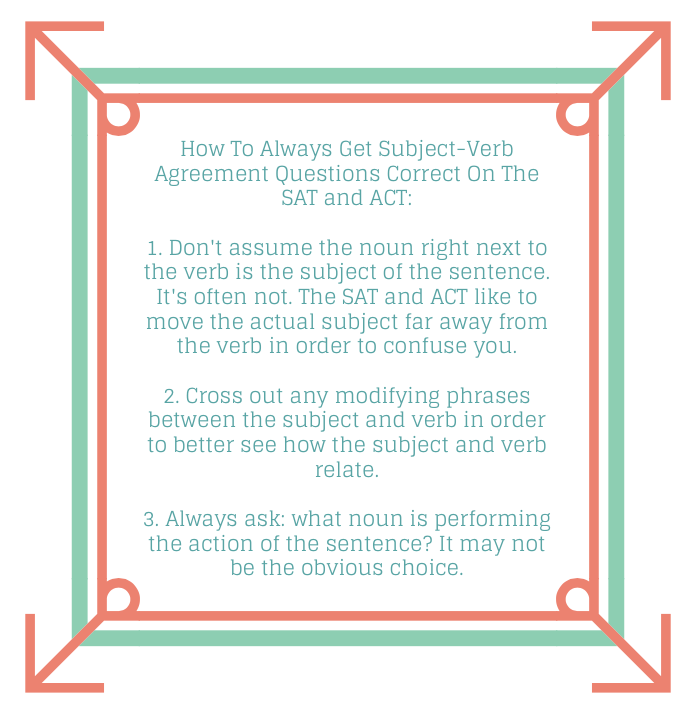One of the most common questions types on SAT Writing and ACT English is the subject-verb agreement question. These questions ask you to make sure that the subject and verb agree. The rule is that a singular subject takes a singular verb, and a plural verb takes a plural subject. For example:
The boy is hungry. –> Singular subject (‘boy’), singular verb (‘is’).
The boys are hungry. –> Plural subject (‘boys’), plural verb (‘are’).
Easy enough, right? That’s why the SAT and ACT have devised three ways to trick you on these questions. Here they are:
1. Placing a prepositional phrase between the subject and verb. Anytime you see a prepositional phrase placed between the subject and verb, think subject-verb agreement. The actual subject of the sentence is not the noun in the prepositional phrase – it’s the noun that the prepositional phrase is describing. Here’s what this looks like:
The boy in the bright red shoes seems cool. –> The test makers want you to think the subject of the sentence is ‘shoes,’ the noun in the prepositional phrase. But the subject will never be the noun in the prepositional phrase. Who seems cool? The boy. If you thought the subject was ‘shoes’ you would have changed ‘seems’ to the plural ‘seem,’ which is exactly what most test takers mistakenly do.
2. Placing a non-essential clause between the subject and verb. If you see a non-essential clause (i.e. phrase that modifies the noun and is offset by two commas) between the subject and verb, think subject-verb agreement. Just like in a prepositional phrase, the noun in a non-essential clause is not the subject of the sentence. The clause merely describes the subject. For example:
The coloring book, which has many pages, is large. –> Many students would choose ‘are’ instead of ‘is’ for the verb here. This is incorrect, however, because the subject of the sentence is the book, not the pages. “Which has many pages” is simply a non-essential clause describing the subject ‘book.’ What’s large? The book, not the pages.
3. Placing the subject after the verb. In English, the subject usually comes before the verb. By reversing this and then placing a singular noun that is not the subject before the verb, the test makers trap you into choosing the wrong verb. Here’s an example:
Inside the house stand many doors. –> Here the subject is not ‘house,’ but the plural ‘doors,’ which takes the plural verb ‘stand.’ ‘Inside the house’ is a prepositional phrase describing the doors. Many students would miss this question by choosing the singular ‘stands’ for the verb because the verb is preceded by the singular noun house. Always ask yourself what is performing the action of the verb. Does the house stand or the do the doors stand? Here, the “doors stand (inside the house).”
Whenever you see a question testing subject-verb agreement, be on the lookout for these three traps. If there is a prepositional phrase or non-essential clause standing between the subject and verb, you can simply cross it out with your pencil in order to more clearly see how the subject and verb relate. Additionally, always ask yourself what noun is performing the action of the sentence. Never assume that the noun closest to the verb is the subject of the sentence!
